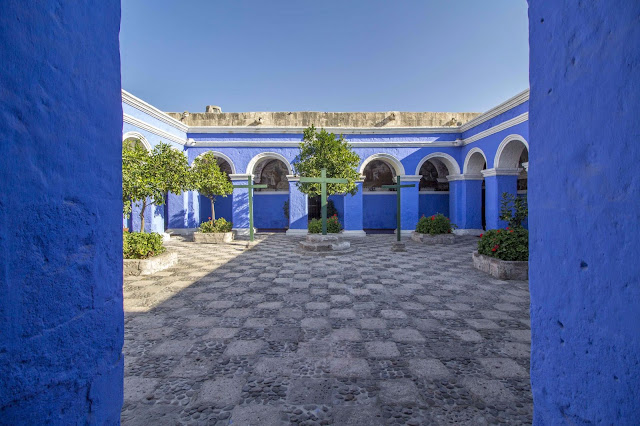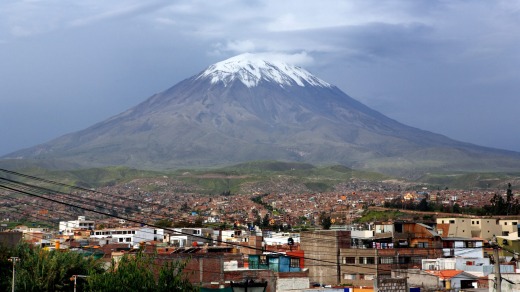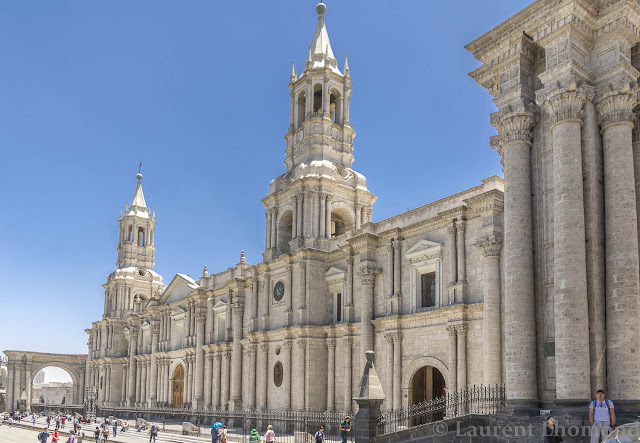
Our overnight bus from Puno was something of a disaster. We were told that we would be picked up from our hostel in Puno at 9.30pm. This didn't actually happen until 10.30pm. We were very, very tired from a full day and early start. En route to the bus station, Jayna managed to lose the lock and key to her bag, and the pac to her pac-a-mac. The bus was at 11pm and was at least a cama bus, though unfortunately the journey was not long enough to give a good amount of sleep, arriving in Arequipa at 4.30am. Jayna was also not well. It was a difficult journey.
We holed ourselves up in a cafe in the bus station, drinking coffee, until it was more of a decent hour. At 8am we went into Arequipa town and went to our hostel, in the hope that they would accept our bags until we could check in. Instead, they allowed us to check in early! After changing rooms, due to a smell of cigarettes and cheese, we went to sleep for about 6 hours
We ventured out for sunset, and found a delicious Turkish place, Fez Istanbul, where we ate falafel. Then we took in a wander of the city centre to get our bearings.
Arequipa is a beautiful place; filled with colonial architecture and white sillar buildings. The central Plaza is probably the most beautiful one we've encountered in our travels to date. On a clear day, the Cathedral in the Plaza is flanked by a snow topped volcano. It's an active region; Arequipa experiences an average of 12 earthquakes a day. Usually three are strong enough to notice. This has meant a lot of building and rebuilding in Arequipa over time, though the city has retained it's charm and the centre really is a lovely place to spend a few days. Arequipa stands at approximately 2300 metres, and is much more temperate than the other Andean regions we have visited.
Our hostel was cheap, so we expected it to be a bit on the run down side. We did expect a toilet seat but none of the rooms had this 'luxury'. Also our en-suite was across the hallway. We ended up changing rooms for a third time when our toilet broke. It was very cheap.
On Saturday 4th, we did some organising and some chores
Later we went to the Monasterio de Santa Catalina, a still active monastery covering 5 acres within the centre of the city. It is in effect a city within a city. It's so big that it has it's own street names. The place dates originally from the sixteenth century, is brightly painted and is pleasing to wander. After we left there, we bumped into David and Jen in the Plaza and arranged to meet for dinner. We then went to the Cathedral in the Plaza, and took in a mandatory guided tour of the cathedral, the attached museum, and the bell tower. We played with the bells for a little while and took in the view across the city. We also learned that in 2001, the bell tower we were playing on, fell through the roof and into the Cathedral. This was following an earthquake, narrowly missing a congregation of worshippers who had been in the cathedral just minutes earlier. Six people in the city were not so fortunate, and died from other things falling on them.
We had dinner with David and Jen in a vegetarian restaurant, Lakshmivan, which was very nice. Once again we caught up on our travels and different experiences, swapping stories. David and Jen also brought us our Death Road t-shirts and CD of pictures, having kindly picked these up for us from the downhilling company in La Paz. We took in the night time view from the roof of their hostel (their's was, it's safe to say, a nicer hostel than ours), and said our goodbyes again
On Sunday 5th, we organised a tour for the following day to the Canon del Colca, the world's second deepest canyon, to see both the canyon and the resident condors. We also went to the Museo Santuarios Andinos, where we learned about the history of the Incas, and in particular the child sacrifices the Incas made. The very famous child sacrifice, Juanita, was not on display until May. We saw another female child sacrifice, who was frozen, together with a lot of artefacts found with Juanita and the other children.
On Monday 6th, we went to Canon del Colca. This meant being picked up at 2.15am from our hostel, where we had to wait outside as the hostel doors were locked. We weren't actually picked up until 3am, so the tour was running on standard Peruvian time. We were very tired and tried to sleep on the bus. The bus took us north to the canyon. When we stopped for breakfast, this was badly organised, with all the food at one end of the table, and everyone was uncoordinated, so things didn't make their way up the table. It wasn't just us who were tired and feeling the altitude once again. We stopped to admire the terraces, put in place by the Incas, and Jayna stroked a baby alpaca, which was very soft. We stopped into the church at Chivay, and took in the surrounding stalls, which included a Chilean Blue Eagle which swiftly ended up on Jayna's knee, arm and then head
We tipped the owner. It was very soft and tame.
The next stop was at the canyon, and we were spotting viscacha (Andes rabbits) along the way. There were three condors perched on a rock very close to the viewing areas. They are magnificent beasts, standing at over a metre tall and weighing up to 12 kilos. We waited until they flew, which they did, and enjoyed the swooping over and through the canyon. Later another condor appeared and did a fly-by. It was very impressive. The canyon from top to bottom as a height difference of 3400 metres!
On our return journey, we stopped to admire more terraces and a disused copper mine, and lots and lots of alpacas. We then took a swim in the 'hot springs' (heated pool), which was very nice. We had a very expensive lunch and spoke to a lovely New Zealander, before taking in the views of lots of volcanoes at the highest point in the journey, at 4900 metres. It was then a long journey back to Arequipa.
When we arrived back at Arequipa, we booked some onward bus travel, moved rooms again in our hostel, and enjoyed a potato based meal at Hatunpa, where we ate seven different kinds of potatoes, together with lots of other yummy stuff. Apparently, there are over 3800 varieties of potato in Peru alone.
We packed and got ready for our next stop - Nazca!



